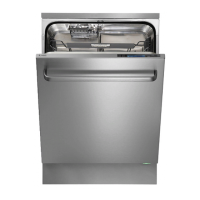Using the dishwasher
Add detergent
1 Prewash detergent compartment
2 Main wash detergent compartment
Detergent is added according to water hardness.
Follow the instructions on the detergent packaging.
Too much detergent can result in less effective dishwashing and
also entails greater environmental impact.
Add the detergent to the detergent compartment. There is one
compartment for the prewash and one for the main wash. If tablets
are not used, add a small amount of the detergent to the prewash
compartment. Contact the detergent manufacturer if you have
any questions about the detergent.
WARNING!
Children must be supervised – dishwasher detergent is
corrosive!
NOTE!
Use only dishwasher detergent! Washing up liquid must not
be used as the foam that forms prevents the dishwasher from
operating effectively.
Dishwasher tablets
Halve the tablet if it is difficult to close the dispenser lid. There is
a risk that the detergent will not be released properly if the lid is
tight and will not open correctly.
NOTE!
Dishwasher tablets are not recommended for short programs
(less than 75 minutes). Use powder or liquid dishwasher
detergent instead.
3–in–1/All-in-one detergent
Read through the directions for these products carefully. If
anything is unclear, contact the detergent manufacturer.
Program selection
Press the Program selector one or more times until the desired
program appears on the display.
Daily wash
A program suitable for day-to-day dishwashing. This program
can also clean dried leftovers, but is not intended for burnt food,
such as on oven dishes.
Time program
The program adapts to the specified running time or finish time.
With this program it is important to choose a time suited to how
dirty the dishes are.
Slightly dirty dishes0:30-1:15
Normally dirty dishes1:30-2:00
Very dirty dishes2:15-3:00
Heavy wash
Program for very dirty dishes, such as pans, casserole dishes
and oven dishes. If these dishes do not completely fill the
dishwasher, you can add plates and the like.
Normal wash
Use to wash normally dirty dishes, such as plates, serving dishes,
cups, glasses and so on.
For washing normally soiled mixed loads, with the best energy
and water performance, use the Normal wash program with
temperature 50 °C and short drying .
If you want to improve the dishwashing and drying result select
the options 65 °C and long drying . This causes a slight
increase in energy consumption.
Mixed wash
This dishwashing program is used when you have lightly soiled
dishes in the upper basket and heavily soiled dishes in the lower
basket. This program has a longer program time than Lower half
wash.
Upper half wash
You can use this program if you only have cups and glasses that
need washing in the upper basket. Slightly dirty dishes can also
be placed in the lower basket.
Lower half wash
You can use this program when you only want to wash plates
and cutlery in the lower basket. Slightly dirty dishes can also be
placed in the upper basket.
Eco wash
Use when you want to save water. For normally dirty dishes.
Plastic wash
A program intended for washing plastic items that are dishwasher
safe. This program has an extra long drying cycle. Porcelain and
glasses can also be washed.
Delicate wash
If the dishes are not very dirty, you can select Delicate wash. This
program is intended for glasses and porcelain that have just been
used and as such do not require such a powerful program.
This program can be used for fragile dishes. Select No dry if you
want to be especially cautious. See also the section Fragile dishes
in the chapter Loading the dishwasher.
Quick wash
This program is used for glasses and porcelain that is slightly
dirty, such as coffee cups.
Super Quick wash
Short program lasting about 15 minutes with acceptable results
for very slightly dirty dishes.
9

